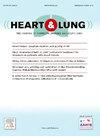Volume OXygenation index in predicting the efficacy of early non-invasive ventilation in patients with acute hypoxic respiratory failure: A multicenter study
IF 2.6
4区 医学
Q2 CARDIAC & CARDIOVASCULAR SYSTEMS
引用次数: 0
Abstract
Background
The Volume OXygenation (VOX) index was initially designed to predict treatment failure of high-flow nasal cannula therapy. However, its predictive power for non-invasive ventilation (NIV) remains uncertain.
Objectives
To evaluate the predictive capability of the VOX index regarding treatment failure in patients undergoing NIV.
Methods
This retrospective study was conducted in three hospitals from September 2017 to September 2021. Patients with acute hypoxic respiratory failure (AHRF) who underwent early NIV treatment were categorized into high-risk and low-risk groups based on the 2-hour NIV VOX Youden index.
Results
At 2 h of NIV, the area under the receiver operating characteristic curve for predicting NIV failure using the VOX index was 0.843 (95 % CI 0.805–0.882). Using a VOX value threshold of 20.45 to predict NIV failure, the sensitivity was 69.1 %, and the specificity was 94.4 %. Following NIV treatment, the low-risk group had a lower intubation rate (7.98 % vs. 77 %, P < 0.05) and mortality rate (4.79 % vs. 17.5 %, P < 0.05).
Conclusion
In early NIV treatment for AHRF, the VOX index obtained after 2 h of NIV demonstrates a strong predictive power for NIV failure. Patients with a VOX value > 20.45 have a low probability of NIV failure, suggesting that it can be used as an evaluation index to assess the efficacy of NIV.
容积氧合指数预测急性缺氧性呼吸衰竭患者早期无创通气疗效:一项多中心研究
研究背景:容积氧合(VOX)指数最初是用来预测高流量鼻插管治疗失败的。然而,其对无创通气(NIV)的预测能力仍不确定。目的评价VOX指数对无创通气患者治疗失败的预测能力。方法回顾性研究于2017年9月至2021年9月在三家医院进行。根据2小时NIV VOX Youden指数将早期接受NIV治疗的急性缺氧呼吸衰竭(AHRF)患者分为高危组和低危组。结果在NIV 2 h时,使用VOX指数预测NIV失效的受试者工作特征曲线下面积为0.843 (95% CI 0.805 ~ 0.882)。使用20.45的VOX阈值预测NIV失败,敏感性为69.1%,特异性为94.4%。经NIV治疗后,低危组插管率较低(7.98% vs. 77%, P <;0.05)和死亡率(4.79% vs. 17.5%, P <;0.05)。结论在早期NIV治疗AHRF时,2 h后获得的VOX指数对NIV失败具有较强的预测能力。VOX值>;20.45的受访患者NIV失败的概率较低,可以作为评估NIV疗效的评价指标。
本文章由计算机程序翻译,如有差异,请以英文原文为准。
求助全文
约1分钟内获得全文
求助全文
来源期刊

Heart & Lung
医学-呼吸系统
CiteScore
4.60
自引率
3.60%
发文量
184
审稿时长
35 days
期刊介绍:
Heart & Lung: The Journal of Cardiopulmonary and Acute Care, the official publication of The American Association of Heart Failure Nurses, presents original, peer-reviewed articles on techniques, advances, investigations, and observations related to the care of patients with acute and critical illness and patients with chronic cardiac or pulmonary disorders.
The Journal''s acute care articles focus on the care of hospitalized patients, including those in the critical and acute care settings. Because most patients who are hospitalized in acute and critical care settings have chronic conditions, we are also interested in the chronically critically ill, the care of patients with chronic cardiopulmonary disorders, their rehabilitation, and disease prevention. The Journal''s heart failure articles focus on all aspects of the care of patients with this condition. Manuscripts that are relevant to populations across the human lifespan are welcome.
 求助内容:
求助内容: 应助结果提醒方式:
应助结果提醒方式:


